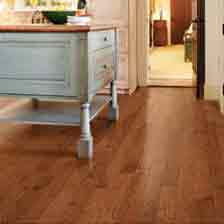The Top 10 Flooring Mistakes to Avoid
Shopping for new floors? Filled with trepidation and worried you will make an expensive mistake? Don’t feel alone----almost everybody feels that way! We understand that this is something you have probably never done before, there are so many choices, and so much information to absorb. You are smart to learn from the experience of others. Here’s a list of the Top 10 flooring mistakes to avoid:
- 1. Selecting the Flooring Product Without Considering Your Needs and Lifestyle.
There is no universal best type of flooring for everybody. Different types of floors will hold up differently depending on factors such as traffic, pets, kids, etc. Knowing your family’s lifestyle and picking a flooring that fits into that lifestyle is something that a lot of people don’t consider. For example, picking a high gloss hardwood floor when you have young kids and pets is setting the floor up for failure. All floors have their pros and cons. You need to take the time to determine which product will best meet your needs (lifestyle, budget, appearance, maintenance, etc.) while creating the fewest concerns. Spend time talking with flooring professionals and be honest about what you do not like about your current floor and then listen to the recommendations and advice. Be open to products you have not considered or did not know existed.
- 2. Falling For Advertising Gimmicks
There are lots of claims that companies will make to get customers in the door: “buy one room, get two free” or “free installation.” As Clark Howard says, if it sounds too good to be true, it probably is! Companies that advertise these things are not giving you anything for free. The cost to cover the “two free rooms” is hidden in the price of the one room you are paying for, or in the labor charges. Get more than one estimate, make sure you are comparing apples to apples, and look at the bottom line prices.
- 3. Selecting Poor Quality
Putting in new floors is an expensive project. It takes lots of planning and saving to make sure you are getting a high quality product that will last for a long time. You don’t want to end up choosing a product that you’re going to have to replace in a short amount of time because it is poor quality. Ultimately it will cost you more money than you’ll save by going with a low quality flooring.
- 4. Not Understanding What You Are Buying
Picking a new floor can be a daunting task. There are hundreds of different products to choose from and you want to make sure you are getting the best quality product for your budget. All carpet is not the same, just like all cars are not exactly the same. For example, a 30 ounce polyester carpet is totally different and less costly than a 50 ounce nylon carpet, just like a Kia is not at all like a Rolls Royce. The more you know, the easier it will be to make the best choice for your home.
- 5. Putting Too Much Importance On Warranties
It is getting more typical to see longer warranties on flooring. It is important not give these warranties OVER consideration. A warranty exists to protect you as the shopper, but also to protect the manufacturer. The bottom line is a warranty does NOT cover normal wear and tear to a floor. Most of the time, a warranty is only going to cover what would be considered a defective product, such as a wood with a finish that is peeling off or a carpet that is delaminating (coming apart.) Almost all product defects are noticed within the first few months. Rarely do the problems that warranties actually cover develop after 20 years. You do, however, want some kind of warranty on the installation.
- 6. Skimping on Installation
You can buy the best quality product on the market, but if it’s installed incorrectly, there will be problems and it will not last as long as it should. It is important to do research on installation. You are paying a lot of money to put in new floors, so you want them to be installed correctly! When choosing an installer, make sure they are familiar with the product going down and have experience dealing with that product. You want your investment to last for years, so don’t cheat yourself by cutting corners with installation. The very best installers usually do not install a wide variety of products; most specialize in certain areas in order to be a true craftsman.
- 7. Choosing Based on a Small Sample
Deciding on the right color and shade of your new floor is very important. You want it to complement your home and create a visually pleasing setting. It is very difficult to get an accurate idea of what a color will look like based on a 2 inch sample. Whenever possible, you want to see a larger piece of your carpet, wood, tile, etc. to really see how the color will work with the house.
- 8. Accounting For Carpet Seams
A seam in a carpet is needed when two pieces of carpet have to be laid together. The type of carpet plays a large role in how difficult it is to hide the seams, for example, a Berber style is the hardest and a shag is the easiest. Patterned carpets should be given a little more thought in regards to seams, because you want the patterns to match up with each other. Some types of carpet (and vinyl) will require more carpet to be purchased in order to provide the most aesthetically pleasing results, which will add to the cost of the project.
Regardless, carpets will have seams. It’s up to you as the customer to be sure you are choosing an installer who is experienced and knows how to seam different types of carpets to make them less visible.
- 9. Ignoring a Damaged or Uneven Subfloor
A subfloor is the structure upon which all the floors in your home are anchored. Depending on the construction of your home, the subfloor may be cement/concrete or plywood.
Flooring manufacturers require your subfloor be flat, clean, dry, and structurally sound prior to the installation of your new floor. Many flooring products also have requirements as to how level your subfloor must be. Carpet and pad hide the fact that a subfloor is damaged or is not level. Flooring installations can fail due to lack of proper floor prep and leveling. Also, in the event of a product defects claim, the manufacturer’s product warranty can be void due to this improper installation.
Over time, wooden subfloors, like any wooden structure, are subject to damage. Water damage, termites, mold and dry rot can all weaken a wooden structure, making it uneven and more likely to break. The situation is further complicated if your house has settled and sagged. For many floor coverings, the subfloor must be level to within 3/16” over a 10’ span. Cement slabs are usually uneven and this is something that should be corrected prior to the installation of the new hard surface floor.
Installing a new floor atop a damaged or compromised subfloor simply doesn’t make sense. You wouldn’t put an expensive custom paint job on a rusted out car, would you? Of course not. The same principle applies to flooring.
- 10. Not Checking Moisture Content
Moisture in the floor is a very important thing to consider when putting down hardwood floors. Moisture can cause wood to swell or warp, which is why the moisture content needs to be checked before installing hardwoods. It is important to be checked before installing because if the moisture content is too high, steps can be taken to correct the issue before the wood is put down. Moisture is wood’s worst enemy, so you want to make sure you avoid it!
- BONUS TIP
A home improvement contract should spell out the precise work to be performed. "Paint the bedroom" is vague and could be interpreted differently by each party. "Apply two coats of Behr paint to bedroom walls, ceilings and trim" is better, but still not detailed enough. Who is responsible for removing hardware and patching holes? Will the old paint be removed? Will primer be used? Who moves the massive antique wooden furniture? As a general rule of thumb, if a task is not specified in the contract, it is not included in the price.
Be sure you have a fully itemized and detailed contract before you make your decision. A price scrawled on the back of a business card offers you limited information and no protection if a dispute arises. The proposal you are accepting is a legally binding contract. These are some of the items that should be included in the contract:
~rooms the work is being performed in
~brand, color, and quantity of product purchased
~what is included in the installation/labor
~price including sales tax
~payment schedule
~warranty
~any other details/verbal commitments made earlier in the sales presentation
Before you sign the contract, read it thoroughly and ask questions about anything you don’t understand. Once you sign the contract, you are obligated to follow through with the signed agreement, so be careful before you make a commitment. Whether you’re hiring a contractor to beautify your home or to complete some much-needed repairs, you want to hire the most qualified people you can. A poorly chosen contractor could invite problems that you will have to live with later down the road. The right contractor will help relieve some of the stress associated with the home improvement process.





